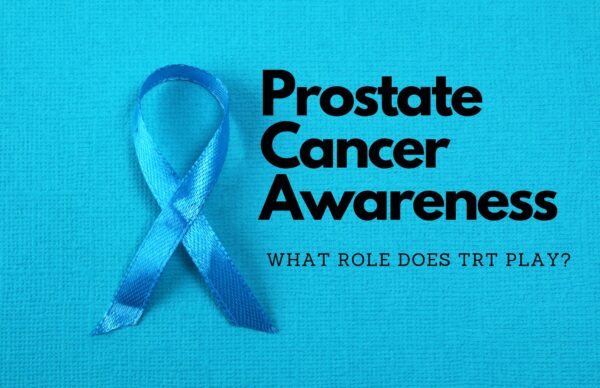Testosterone and Prostate Cancer: Debunking Persistent Myths
Posted by: Men's Health Boston in Uncategorized on June 28, 2023
Science is a complex and dynamic field, filled with uncertainty and ongoing discoveries. As medical providers, we confront this reality every day. Rarely do we possess definitive, all-encompassing answers to the questions we get asked. Instead, we rely on phrases like “The current thinking is…” or “The best evidence at the moment suggests…” in an attempt to distill the complex risk analysis of intricate medical concerns into clear, understandable options for our patients.
Regrettably, this approach can also be a double-edged sword. The pursuit of tidy answers sometimes lends itself to oversimplifications and entrenched beliefs that persist even when scientific data no longer supports them.
In this month’s blog post, we are aiming to directly confront one of the most deeply-rooted controversies in Men’s Health: the link between testosterone replacement therapy and prostate cancer.
Unraveling the truth about testosterone replacement therapy (TRT) and its relationship to prostate cancer is a nuanced task, and research conducted over the past three decades has a lot to tell us on this topic. So, to help us separate fact from fiction, we interviewed MHB’s very own Nurse Kevin Flinn, RN, an expert in men’s sexual health and a long-time collaborator of renowned TRT authority Dr. Abraham Morgentaler, MD, FACS (who happens to be the founder of our clinic).
If you’re looking to discover the latest research findings and debunk the myths surrounding testosterone therapy and prostate cancer, you’ve come to the right place. Buckle up.

The Historical Perspective
According to Nurse Flinn, “The belief that testosterone causes or accelerates prostate cancer originated with the work of Dr. Charles B. Huggins, who won a Nobel Prize for demonstrating that castrating men with metastatic prostate cancer could slow its progression.”

In this case, “castration” refers to a process known as medical or chemical castration, whereby specific androgen-blocking drugs are administered to patients to halt the production of sex hormones. The goal is to take testosterone levels as close to zero as possible. What Dr. Huggins found was not a ‘cure’ per se, but it did buy more time for patients with aggressive prostate cancers.
When Dr. Huggins published his initial findings in 1941, it was considered ground-breaking work. Prostate cancer is still one of the most common forms of cancer in men today, ranking second only to skin cancer. Previously untreatable, Huggins’s work showed that the course of the disease could be impacted by manipulating the sex hormones. His research was revolutionary. However, as is often the case, the devil here is in the details.
“People extrapolated from that [paper] that if you gave men testosterone, you were causing the opposite to happen. If you lower T, you could slow prostate cancer down – but they were taking that information and taking it to a different level,” Kevin explains.
Thus, the misconception was born that testosterone was the cause and/or accelerant of all prostate cancers.
Challenging the Prevailing Belief
This was the scientific backdrop against which Kevin began his career in sexual medicine.
“Back in the 1990’s, when I started working with Dr. Morgentaler at Beth Israel Deaconess Medical Center, and we started to use testosterone for the treatment of men who had low T levels – the belief was that testosterone was linked to causing prostate cancer. Or, if you already had prostate cancer, testosterone would accelerate the growth. It was a major concern for us.”
“So, what we did back then, before we started patients on testosterone, was that we did a [prostate] biopsy on them. We wanted to be safe, because of the thinking at that time. So, we biopsied everyone.”
A prostate biopsy is a minimally invasive procedure using a needle to remove small samples of suspicious tissue from the prostate for closer evaluation. The modern technique often utilizes MRI to better identify suspicious tissue regions and minimize the number of samples needed. But in the early 90’s, an immediate biopsy was the standard of care for any man suspected to be harboring cancer.
In doing so, they discovered a curious trend.
“Through these biopsies, we first found that these [prospective] patients who had low T already had a similar incidence of prostate cancer compared to men with an abnormally elevated PSA even before receiving testosterone replacement,” Kevin notes.
To understand the nuance here, it’s necessary to familiarize yourself with the prostate-specific antigen (PSA) test. As its name suggests, PSA is a protein produced specifically by the cells of the prostate. Circulating levels are measured through blood testing.
PSA levels can rise for a variety of reasons, including when the prostate gland becomes enlarged – a condition known as BPH. Additionally, when prostate cells become cancerous, they often begin producing extra PSA, and blood levels can spike.
Originally utilized to monitor the advancement of disease in men already diagnosed with prostate cancer, PSA was also approved by the FDA for use as a screening tool in 1994. A normal PSA level is thought to be less than 4.0 ng/mL. Anything higher will raise suspicion, and might help trigger the decision to investigate further.
And here’s the key: When Dr. Morgentaler and Nurse Flinn began taking biopsies in prospective patients with low testosterone, they started detecting unusually high rates of cancer in men previously classified as low risk based on normal PSA levels.
They published the unexpected results in the Journal of the American Medical Association (JAMA) in December of 1996. While the biopsy study did not include a randomized, age-matched comparison group, the rate of cancer they detected in these men was just as high as the known cancer rate in men with elevated PSA levels.
In other words, if you were extrapolating the data from Huggins, low levels of testosterone should have been associated with a lower risk of prostate cancer. But that wasn’t what they found.
Kevin continues, “Subsequently, we biopsied a total of 345 patients, and these patients – who had never had testosterone therapy, had low T, and normal PSAs – ended up having prostate cancer at [similar rates] to men in the general population with elevated PSA levels.”
It was the exact opposite of what they had expected, and endorsed their original findings. They published the follow-up data in 2006.
Later research and biopsies on patients with low testosterone levels continued to confirm the surprising results. “This contradiction challenged the prevailing belief and set the stage for further investigation,” Kevin explains.
The Many Shades of Prostate Cancer
For insight into the complicated link between testosterone therapy and prostate cancer, it’s crucial to differentiate between types of prostate cancer.
Whenever cancer cells are identified, they are assigned a ‘grade’ by a pathologist based on how aggressive the cancer appears to be. This grade is known as a Gleason Score. It goes like this:
- Low-grade cancer = Gleason 6 or lower
- Mid-grade cancer = Gleason 7
- High-grade (aggressive) cancer = Gleason 8-10
In today’s thinking, low-grade cancers are thought to be relatively benign. They don’t show signs of aggressive growth, and aren’t likely to move beyond the prostate to other tissues. In many cases, men who have confirmed Gleason 6 or lower-grade cancer cells have a choice: they can choose to treat the cancer through a variety of different techniques – or they can choose NOT to do anything, and instead monitor the cancer closely over time to ensure it does not develop further. This second option is known as ‘active surveillance’.
The distinction is extremely important, because we know that some men on active surveillance will progress to higher grade disease, with or without TRT. But recent studies have cautiously suggested that testosterone therapy does not appear to increase that risk of progression. However, the total number of patients treated in these trials remains too small to draw definitive conclusions.
Aggressive cancer cells, on the other hand, are inherently more prone to spreading outside of the prostate. And these more aggressive cells DO seem to have an affinity for testosterone. This is part of what muddies the water when we discuss TRT with patients.
According to Kevin, “What we worry about with any treatment is: can the cancer cells get outside of the prostate? If the pathologist comes back and says this is a high-grade cancer, say a Gleason 8 or 10, usually the next step for the urologist is to do some other studies. These aggressive prostate cancer cells have specific sites that they tend to choose to [jump] to. Bone is the primary site. So usually, they will do a bone scan or a PET scan to see if there is any sign that the cancer has spread outside of the prostate. If it has spread, usually the patient is not a candidate for surgical options, and they may consider treatments such as medical castration and/or chemotherapy.”
The bottom line? There is no evidence that testosterone inherently promotes the initiation of prostate cancer. However, Huggins’s research still holds true: if a patient has an aggressive form of prostate cancer, most urologists will advise againsttestosterone replacement. And if an existing cancer is low-grade, the question of whether to utilize TRT must weigh the potential benefits vs. the patient’s appetite for risk, knowing that research is not entirely clear on whether TRT affects risk of cancer progression.
Emerging Data: Combating Reoccurrence
To make things even more complicated, modern studies have suggested that there may also be a protective role of testosterone against biochemicalreoccurrence of prostate cancer. This is essentially when men who have been treated by radiation or radical prostatectomy – an operation in which the prostate is surgically removed to prevent cancer cells from spreading to neighboring tissues – experience a relapse in diagnosis.
If the old paradigm were true, you would expect the cancer to reoccur more regularly in men with higher levels of testosterone. And yet again, the data tells us otherwise.
As Kevin puts it, “So, you have two guys; both have had a radical prostatectomy. One has low T, one has normal T. The guy with low T has a higher risk of reoccurrence than the guy with normal T. That’s what some of the studies are showing, as of today.”
“I remember, in the beginning, when we would go to conferences with all urologists in the audience, Dr. Morgentaler would ask, ‘How many of you would treat men who have a history of prostate cancer that has been treated?’ Back then, in the early days, NOBODY would raise their hand. If you went to a conference today at the American Urological Association and asked urologists how many would treat men with low T who are symptomatic and who have been treated for prostate cancer, you would see lots of hands go up. Probably 80-90%.”
Debunking The Controversy
Despite the extensive research and paradigm shift, misconceptions surrounding testosterone and prostate cancer persist. Kevin acknowledges that this is partly due to the slow nature of change in medical beliefs and the lack of awareness among primary care doctors. “A lot of primary care docs are just not up to that data.”
Additionally, the FDA, by design, tends not to be an early adopter of new evidence. “The other important point is that, unfortunately, the FDA has put in all formulary print-outs with any treatment with testosterone that it is contraindicated in patients with a history of prostate cancer. Because the FDA has done that, it continues to feed the confusion,” he adds.
The Importance of Informed Decision-Making
Updated guidelines from the American Urological Association (AUA) do emphasize the absence of evidence linking testosterone therapy to the development of prostate cancer.

In addition, Kevin continues to encourage an informed decision-making process, stating, “The decision to pursue TRT should be a collaborative discussion between patients and their clinicians. Right now, we don’t have enough evidence to fully quantify the risk/benefit ratio of testosterone therapy, so informed consent needs to acknowledge the current lack of clarity on the subject.”
However, there is reason to be optimistic.
Further investigations are underway, with preliminary data from the highly-anticipated TRAVERSE trial seeing publication earlier this month. The FDA mandated the study in 2015, involving nearly 6,000 patients followed over a period of 5 years to elucidate the relationship between TRT and cardiovascular risk.
We won’t dig deep on the TRAVERSE results today, as the study deserves its own write-up. However, notably, the research subjects were also followed for the development of prostate cancer during the trial. And encouragingly, while a slightly higher bump in baseline PSA levels was observed in the TRT group, there was no significant difference in development of prostate cancer between the treatment group and the placebo group.
Science is a complex and dynamic field, filled with uncertainty and ongoing discoveries. But the momentum of the moment favors a much more nuanced conversation around testosterone replacement.
Interested in TRT?
At Men’s Health Boston, we don’t just help our patients live longer; we help them live better.
If you or someone you know are suffering from possible symptoms of low testosterone and are seeking a trusted clinician to work with, we can help. For more information on our industry-leading care at MHB, click here. For a clinical evaluation, call our office or request an appointment with one of our expert providers today.

